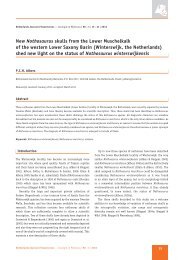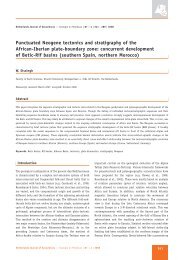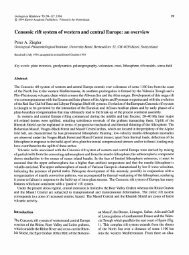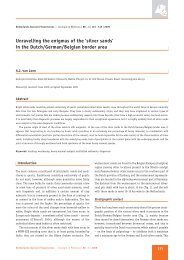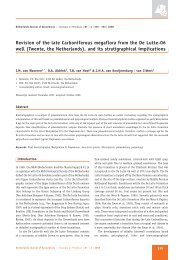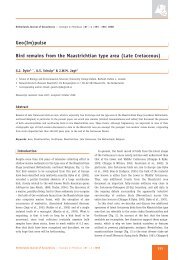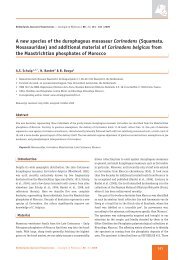Diagnostic sedimentary structures of the fluvial-tidal transition zone ...
Diagnostic sedimentary structures of the fluvial-tidal transition zone ...
Diagnostic sedimentary structures of the fluvial-tidal transition zone ...
Create successful ePaper yourself
Turn your PDF publications into a flip-book with our unique Google optimized e-Paper software.
suppression <strong>of</strong> turbulence by suspended bed material (Bridge<br />
and Best, 1988). This hypo<strong>the</strong>sis finds already some support<br />
in <strong>the</strong> classical experiments <strong>of</strong> Jopling (1966). Thus, in <strong>the</strong><br />
<strong>fluvial</strong>-<strong>tidal</strong> <strong>transition</strong>al <strong>zone</strong>, <strong>tidal</strong> fluctuations <strong>of</strong> flow<br />
strength might be reflected in minor cyclic up and down<br />
migrations <strong>of</strong> <strong>the</strong> brinkpoint in <strong>the</strong> top set structure <strong>of</strong> dune<br />
or bar deposit (see uppermost drawing in Table 1).<br />
Cyclic decimetre sequences in <strong>tidal</strong> and <strong>fluvial</strong> environments<br />
and in <strong>the</strong> <strong>fluvial</strong>-<strong>tidal</strong> <strong>transition</strong>al <strong>zone</strong> generally are forced<br />
Fig. 13. This Figure shows<br />
a number <strong>of</strong> photos made<br />
from a single stratigraphic<br />
level in <strong>the</strong> Hambach<br />
exposure. The distance<br />
between photos a and e<br />
is about 1 km. The outcrop<br />
was parallel to <strong>the</strong><br />
pale<strong>of</strong>low direction (downriver<br />
is to <strong>the</strong> left). In<br />
strike section a wide multichannel<br />
architecture was<br />
visible, displaying IHS.<br />
(see also Fig. 6), <strong>the</strong><br />
<strong>structures</strong> shown in this<br />
figure are part <strong>of</strong> <strong>the</strong><br />
filling <strong>of</strong> one <strong>of</strong> <strong>the</strong>se<br />
channels.<br />
a. Upper region <strong>of</strong> <strong>fluvial</strong><strong>tidal</strong><br />
<strong>zone</strong>: a stack <strong>of</strong><br />
coarse-grained X-bedded<br />
sets partly with low<br />
foreset angle can be seen<br />
associated with pebble<br />
lags. In <strong>the</strong> middle <strong>of</strong> <strong>the</strong><br />
photo a set, indicated by<br />
A, with numerous weak<br />
discontinuity planes marks<br />
<strong>the</strong> remote <strong>tidal</strong> effect.<br />
b. In <strong>the</strong> lower half <strong>of</strong><br />
this lacquer peel X-bedded<br />
sets <strong>of</strong> <strong>the</strong> type<br />
shown in photo a contain<br />
a few clay drapes. Upward<br />
<strong>the</strong> lithology becomes<br />
increasingly clayey while<br />
grading into lenticular<br />
bedding.<br />
300<br />
a.<br />
b.<br />
by neap-spring or seasonal variations. Their preservation<br />
implies a steady and high rate <strong>of</strong> ongoing sedimentation,<br />
without <strong>the</strong> interference <strong>of</strong> any important erosional event.<br />
Favourite subenvironments that <strong>of</strong>fer <strong>the</strong>se conditions are<br />
abandoned channels and inner bends <strong>of</strong> meandering channels.<br />
In <strong>the</strong> latter case <strong>the</strong> microsequences are superimposed on <strong>the</strong><br />
inclined master bedding planes <strong>of</strong> a point bar. On a larger scale<br />
<strong>of</strong> observation this would classify <strong>the</strong>se deposits as Inclined<br />
Heterolitic Strata (IHS). This term was proposed by Thomas et<br />
Ne<strong>the</strong>rlands Journal <strong>of</strong> Geosciences — Geologie en Mijnbouw | 86 – 3 | 2007



